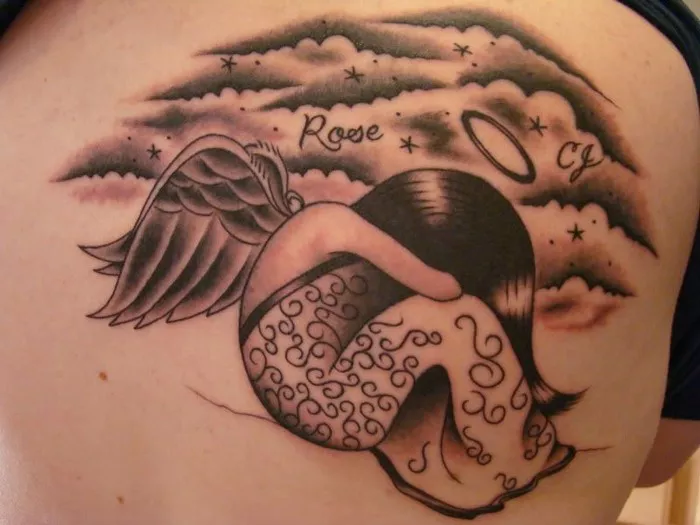In the realm of body art, tattoos serve as a canvas for personal expression, with each design carrying its own unique significance. Among the myriad of tattoo motifs, the image of a sad angel holds a particularly poignant allure, captivating both the wearer and the observer alike. But what does a sad angel tattoo truly symbolize? To unravel the layers of meaning behind this evocative emblem, one must delve into the realms of mythology, spirituality, and personal interpretation.
The Mythological Roots of Angels
Angels, revered across various cultures and religions, are often depicted as celestial beings endowed with divine attributes. In Christian theology, angels are messengers of God, tasked with carrying out His will and offering guidance to humanity. These ethereal entities are envisioned as benevolent guardians, radiating an aura of serenity and grace.
However, the portrayal of angels extends far beyond the confines of Christianity. Ancient mythologies abound with celestial beings akin to angels, albeit with distinct cultural nuances. In Greek mythology, winged figures such as Nike, the goddess of victory, and Eros, the god of love, share parallels with the angelic archetype, symbolizing concepts of triumph and affection respectively.
The Symbolism of Sadness in Angelic Imagery
While angels are typically associated with purity and joy, the incorporation of sadness into their depiction adds a layer of complexity to their symbolism. A sad angel tattoo, with its downcast eyes and melancholic demeanor, evokes a sense of introspection and vulnerability. It serves as a visual reminder of the inherent duality within the human experience, where moments of sorrow coexist with those of joy.
One interpretation of the sad angel motif is that it represents resilience in the face of adversity. Just as angels are believed to possess unwavering strength and unwavering resolve, so too can individuals draw inspiration from their sorrowful visage to confront life’s challenges with courage and fortitude.
Moreover, the depiction of sadness in angelic imagery may also serve as a reflection of the wearer’s own emotional journey. For some, a sad angel tattoo may symbolize a period of mourning or loss, serving as a tribute to departed loved ones and a source of solace in times of grief. In this context, the tattoo becomes a deeply personal emblem of remembrance and resilience, honoring the memory of those who have passed on while reaffirming the wearer’s own inner strength.
Navigating the Spiritual Landscape
Beyond its psychological and emotional connotations, the sad angel tattoo holds significance within the realm of spirituality. For believers, angels serve as intermediaries between the earthly realm and the divine, offering comfort and guidance to those in need. In this light, the image of a sad angel may be interpreted as a symbolic representation of spiritual struggle and redemption.
The juxtaposition of sadness with angelic imagery underscores the notion of spiritual growth through adversity. Just as the archetypal fallen angel is said to have experienced a fall from grace before finding redemption, so too can individuals find solace and renewal amidst the trials of life. In this sense, the sad angel tattoo becomes a testament to the resilience of the human spirit and the transformative power of faith.
Personal Interpretations and Symbolic Variations
Like all forms of body art, the meaning of a sad angel tattoo is ultimately subjective, shaped by the unique experiences and perspectives of the wearer. While some may resonate with the idea of resilience and spiritual redemption, others may interpret the imagery in entirely different ways.
For some, the sad angel tattoo may serve as a symbol of empathy and compassion, representing a deep-seated empathy for the suffering of others. In this interpretation, the tattoo becomes a visual reminder to extend kindness and support to those in need, embodying the virtues of empathy and altruism.
Alternatively, the sad angel motif may be seen as a reflection of existential angst and longing for transcendence. In a world fraught with uncertainty and impermanence, the image of a sorrowful angel may evoke a sense of longing for a higher purpose or spiritual fulfillment.
Conclusion
In the realm of tattoo symbolism, the image of a sad angel stands as a potent emblem of human emotion and spiritual aspiration. Rooted in mythological lore and infused with personal interpretation, the sad angel tattoo serves as a canvas for introspection, resilience, and spiritual exploration.
Whether worn as a tribute to lost loved ones, a symbol of empathy and compassion, or a reflection of existential longing, the sad angel tattoo holds a profound significance for those who choose to adorn themselves with its somber visage. In its fusion of sorrow and serenity, darkness and light, the sad angel serves as a timeless reminder of the complexity of the human experience and the enduring quest for meaning amidst life’s trials and tribulations.

